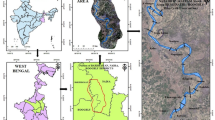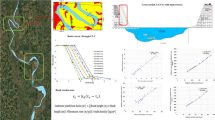Abstract
Rivers are crucial sources of water with multi-faceted applications, and effective river engineering involves addressing sedimentation and erosion concerns. The Kabul River, owing to its strategic significance and environmental implications, garners significant attention in Afghanistan. This stems from its role in water project design, existing reservoirs, and urban and industrial water supply in Kabul. Notably, the Kabul River bears the highest sediment loads among Afghanistan’s rivers, leading to pronounced sedimentation issues in Kabul city. This study employs the Hydrologic Engineering Centre River Analysis System (HEC-RAS) model to comprehensively assess hydrological parameters and sedimentation processes. The analysis encompasses variations in transverse and longitudinal profiles, fluctuations in velocity and shear stress, changes in mass distribution, alterations in bed levels, evaluations of total sediment, erosion dynamics, and deposition patterns. Focusing on a 40-km stretch, spanning from the Pul-i-Surkh station in Maidan Province to the Tangi-Gharo station in Kabul City, the study also accounts for contributions from branch rivers and streams, augmenting sediment volumes. Urbanization, non-standard constructions near the river, and the demand for enhanced sanitation infrastructure contribute to heightened sedimentation. The river’s intermediate segment exhibits a variable slope, intensifying sediment-related challenges. Spanning from January 2016 to June 2020, this research period encapsulates diverse conditions in Kabul City and the intricate dynamics of sediment transport, erosion, and sedimentation processes. The study contributes a comprehensive framework to comprehend Kabul City’s conditions and the complex consequences of sediment-related processes.












Similar content being viewed by others
References
F. Azarang, M.S. Bajestan, Simulating the erosion and sedimentation of Karun alluvial river in the region of Ahvaz (southwest of Iran). Am. J. Eng. Res. 4(7), 233–245 (2015)
W.H. Safi, V. Prasad, R. Khare, Simulation for sedimentation assessment a case study of Kunar River in Afghanistan. Int. J. Adv. Res. 5(2), 406–416 (2017)
B. Panikkar, A. Zia, S. Sgorbati, M. Cohen, M. Abid, M.F. Faiz, N. Salimee, Transboundary water governance in the Kabul river basin: implementing environmental and public diplomacy between Pakistan and Afghanistan. Complex. Gov. Netw. 5(1), 101–120 (2019)
H.F. Ahmad, A. Alam, M.S. Bhat, S. Ahmad, One dimensional steady flow analysis using HECRAS–a case of river Jhelum, Jammu and Kashmir. Eur. Sci. J. 12, 340–350 (2016)
M. H. B. S. A. Daham, “Simulation of sediment transport in the upper reach of Al-Gharraf river”, Int. Conf. Geotech. Eng.-Iraq, IOP Publishing Ltd, pp. 1–11, (2020)
C. Tundu, M.J. Tumbare, J.M. Kileshye Onema, Sedimentation and its impacts/effects on river system and reservoir water quality: case study of Mazowe catchment, Zimbabwe. Proc. Int. Assoc. Hydrol. Sci. 377, 57–66 (2018)
M.M. Ezzeldin, O. Rageh, M.I. Saad, Navigation channel problems due to sedimentation, Arab academy for science. Tech. Mar. Transp. Int. Mar. Log. Conf. Marlog. 8, 1–18 (2019)
S. N. Tiwari Harinarayan, "A case study of wangchu (bhutan) reservoir sedimentation using hec-ras", pp. 122–123, (2012)
M.E. Mohammad, N. Al-Ansari, I.E. Issa, S. Knutsson, Sediment in Mosul Dam reservoir using the HEC-RAS model. Lakes Res. Res. Manag. 21(3), 235–244 (2016)
H.W. Fang, R.X. Lai, B.L. Lin, X.Y. Xu, F.X. Zhang, Y.F. Zhang, Variational-based data assimilation to simulate sediment concentration in the lower yellow river, China. J. Hydrol. Eng. 21(5), 04016010 (2016)
M.E. Jahromi, S.H. Afzali, Application of the HBMO approach to predict the total sediment discharge. Iran. J. Sci. Technol. Trans. Civil Eng. 38, 123 (2014)
S. Kumar, A. Jaswal, A. Pandey, N. Sharma, Literature Review of dam break studies and inundation mapping using hydraulic models and GIS. Int. Res. J. Eng. Technol. 4(5), 55–61 (2017)
Wang J. Numerical simulation of sediment-laden flow on the Yarlung Zangbo River incorporating the climate change. In: IOP conference series: earth and environmental science (Vol 467, No 1). IOP Publishing (2020), p. 012057
A.H. Haghiabi, E. Zaredehdasht, Evaluation of HEC-RAS ability in erosion and sediment transport forecasting. World Appl. Sci. J. 17(11), 1490–1497 (2012)
G.W. Brunner, S. Gibson, Sediment transport modeling in HEC RAS. In Imp. Glob. Climate Change (2005). https://doi.org/10.1061/40792(173)442
H. Rasouli, R.B. Kayastha, B.C. Bhattarai, A. Shrestha, H. Arian, R. Armstrong, Estimation of discharge from upper Kabul river Basin, Afghanistan using the snowmelt runoff model. J. Hydrol. Meteorol. 9(1), 85–94 (2015)
S. H. &. S. W. N. Sadid, "An overview of hydro-sedimentological characteristics of intermittent rivers in Kabul region of Kabul river Basin", Institute for modelling hydraulic and environmental systems, University of Stuttgart, Stuttgart, Germany, pp. 1-8, (2016)
G. R. L. M. M. R. Neekita Joshi, "Application of HEC-RAS to study the sediment transport characteristics of Maumee river in Ohio", World Env. Water Res. Congr., pp. 257–267, (2019)
A.S. Mustafa, S.O. Sulaiman, K.M. Al Alwani, Application of HEC RAS model to predict sediment transport for Euphrates river from Haditha to heet 2016. Al Nahrain J. Eng. Sci. 20(3), 570–577 (2017)
S.A. Rahman, D. Chakrabarty, Sediment transport modelling in an alluvial river with artificial neural network. J. Hydrol. 588, 125056 (2020)
Y.C.Y.U.Y. Kuriyama, Numerical simulation of sedimentation and erosion caused by the 2011 Tohoku Tsunami in Oarai Port, Japan. Mar. Geol. 427, 1–12 (2020)
L.G. Castillo, J.M. Carrillo, M.A. Álvarez, Complementary methods for determining the sedimentation and flushing in a reservoir. J. Hydraul. Eng. 141(11), 05015004 (2015)
J.T. Gilbert, A.C. Wilcox, Sediment routing and floodplain exchange (SeRFE): a spatially explicit model of sediment balance and connectivity through river networks. J. Adv. Model. Earth Syst. 12(9), 002048 (2020)
Funding
This study received funding from the Water Resources and Environmental Engineering Faculty, Department of Hydraulic and Hydraulics Structure Engineering at Kabul Polytechnic University.
Author information
Authors and Affiliations
Corresponding author
Ethics declarations
Conflict of interest
The authors confirm that no conflicts of interest exist.
Additional information
Publisher's Note
Springer Nature remains neutral with regard to jurisdictional claims in published maps and institutional affiliations.
Rights and permissions
Springer Nature or its licensor (e.g. a society or other partner) holds exclusive rights to this article under a publishing agreement with the author(s) or other rightsholder(s); author self-archiving of the accepted manuscript version of this article is solely governed by the terms of such publishing agreement and applicable law.
About this article
Cite this article
Raji, B.M., Turabi, H. & Nasimi, M.N. Sedimentation Analysis of Kabul River by Using HEC-RAS. J. Inst. Eng. India Ser. A 105, 229–238 (2024). https://doi.org/10.1007/s40030-023-00774-1
Received:
Accepted:
Published:
Issue Date:
DOI: https://doi.org/10.1007/s40030-023-00774-1




